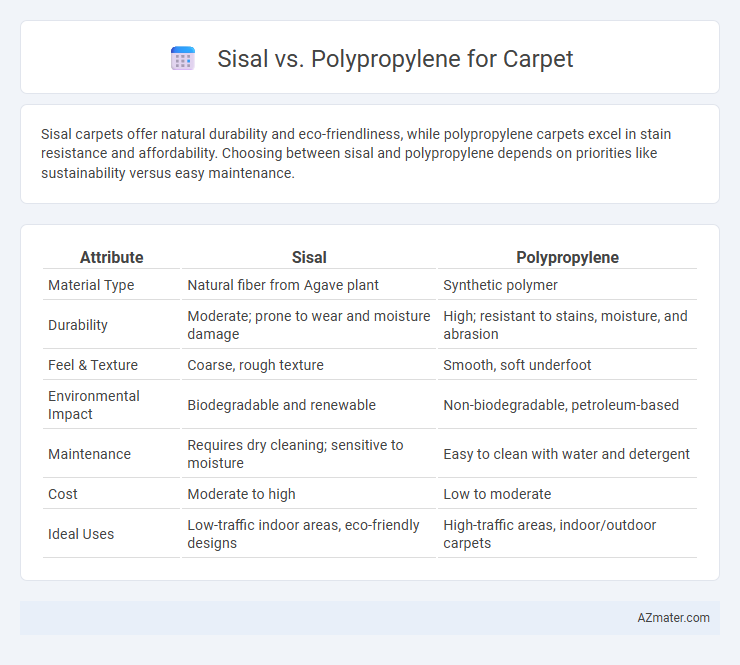Sisal carpets offer natural durability and eco-friendliness, while polypropylene carpets excel in stain resistance and affordability. Choosing between sisal and polypropylene depends on priorities like sustainability versus easy maintenance.
Table of Comparison
| Attribute | Sisal | Polypropylene |
|---|---|---|
| Material Type | Natural fiber from Agave plant | Synthetic polymer |
| Durability | Moderate; prone to wear and moisture damage | High; resistant to stains, moisture, and abrasion |
| Feel & Texture | Coarse, rough texture | Smooth, soft underfoot |
| Environmental Impact | Biodegradable and renewable | Non-biodegradable, petroleum-based |
| Maintenance | Requires dry cleaning; sensitive to moisture | Easy to clean with water and detergent |
| Cost | Moderate to high | Low to moderate |
| Ideal Uses | Low-traffic indoor areas, eco-friendly designs | High-traffic areas, indoor/outdoor carpets |
Introduction to Sisal and Polypropylene Carpets
Sisal carpets, made from natural fibers derived from the agave plant, offer eco-friendly durability and a distinctive textured appearance ideal for high-traffic areas. Polypropylene carpets, crafted from synthetic polymer fibers, provide stain resistance, affordability, and a wide range of colors and patterns suitable for versatile interior styles. Choosing between sisal and polypropylene depends on preferences for natural materials versus practical maintenance and resilience.
Material Composition: Natural vs Synthetic
Sisal carpet fibers are derived from the natural leaves of the Agave sisalana plant, offering a biodegradable and eco-friendly option characterized by durability and a coarse texture. Polypropylene carpets are made from synthetic thermoplastic polymer fibers, known for their moisture resistance, stain repellency, and affordability. The choice between natural sisal and synthetic polypropylene influences carpet performance, environmental impact, and maintenance requirements.
Durability and Longevity Comparison
Sisal carpets, made from natural fibers of the agave plant, offer strong durability with a firm texture that resists wear but may be prone to moisture damage and staining. Polypropylene carpets, synthetic and stain-resistant, provide superior protection against moisture, mold, and fading, making them ideal for high-traffic areas and outdoor use. When comparing longevity, polypropylene typically outperforms sisal due to its resilience to environmental factors and easier maintenance.
Aesthetic Appeal and Style Options
Sisal carpets offer a natural, earthy aesthetic with a textured surface that enhances rustic and bohemian interiors, while polypropylene carpets provide a wide range of vibrant colors and patterns, catering to modern and eclectic styles. The natural fibers of sisal create subtle variations in tone and texture that add depth and organic charm, whereas polypropylene's synthetic composition allows for consistent hues and intricate designs resistant to fading. Choosing between sisal and polypropylene depends on whether the priority is natural elegance or versatile, bold style options.
Stain and Moisture Resistance
Polypropylene carpets offer superior stain and moisture resistance compared to sisal, as polypropylene fibers repel liquids and resist mold growth. Sisal, being a natural fiber, is more absorbent and prone to staining and moisture damage, requiring careful maintenance. For high-traffic or damp areas, polypropylene carpets provide a more durable and easy-to-clean option.
Comfort and Texture Differences
Sisal carpets offer a natural, coarse texture that provides firm underfoot support, making them ideal for high-traffic areas but less comfortable for prolonged standing or barefoot walking. Polypropylene carpets, made from synthetic fibers, deliver a softer, cushioned feel that enhances comfort and warmth, suitable for living spaces where comfort is prioritized. The difference in material composition directly affects durability and tactile sensation, with polypropylene excelling in plushness and stain resistance, while sisal emphasizes durability and organic texture.
Environmental Impact and Sustainability
Sisal carpets are made from natural fibers derived from the Agave plant, making them biodegradable and renewable with low environmental impact during production. Polypropylene carpets, though affordable and resistant to stains, are synthetic and non-biodegradable, contributing to plastic pollution and higher carbon emissions throughout their lifecycle. Choosing sisal over polypropylene supports sustainable practices by reducing reliance on petroleum-based materials and promoting eco-friendly disposal options.
Maintenance and Cleaning Requirements
Sisal carpets require gentle, dry cleaning methods to prevent moisture damage and fiber shrinkage, making vacuuming the preferred maintenance approach for everyday debris. Polypropylene carpets are stain-resistant and can withstand wet cleaning techniques, such as steam cleaning or spot washing, allowing for more aggressive stain removal and easier upkeep. The inherent durability and moisture resistance of polypropylene make it a low-maintenance option compared to the natural fiber sensitivity of sisal.
Cost Analysis: Budget Considerations
Sisal carpets generally present a higher initial investment due to natural fiber sourcing and more labor-intensive production processes, while polypropylene options offer a more budget-friendly price point because of synthetic manufacturing efficiencies. Maintenance costs for sisal can also be higher, considering its susceptibility to moisture and staining, which may require specialized cleaning products. Polypropylene carpets benefit from lower upkeep expenses, making them a preferred choice for cost-conscious consumers seeking durable and easy-to-clean flooring solutions.
Which Carpet Material is Best for Your Needs?
Sisal carpets offer natural durability and eco-friendly benefits with a coarse texture suited for low-traffic areas, while polypropylene carpets provide stain resistance, affordability, and softness ideal for high-traffic or moisture-prone spaces. Choosing between sisal and polypropylene depends on your priorities: natural fibers and organic appeal versus practical maintenance and cost efficiency. For homes with pets or children, polypropylene's resilience makes it a preferred choice, whereas sisal suits those seeking sustainable, artisanal flooring aesthetics.

Infographic: Sisal vs Polypropylene for Carpet
 azmater.com
azmater.com